





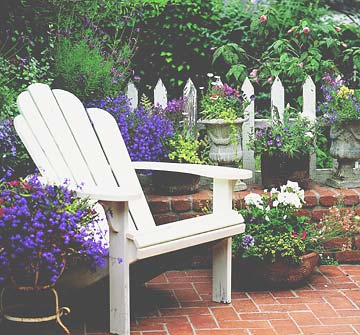 Details like chairs, benches, and
planters can draw people to your
patio.
Details like chairs, benches, and
planters can draw people to your
patio.
Furniture. The most common and useful amenity for a patio is furniture. It provides a place to sit, dine, or otherwise enjoy the space, and it helps organize the space. When choosing patio furniture, consider the style and how it matches the surroundings, as well as how comfortable and durable it is. Outdoor furniture that has to be protected or that stains easily when exposed to the elements will probably prove to be more trouble than it is worth. Invest in furniture that will stand up over time without a lot of extra care.
Designing for Outdoor Living
continue reading below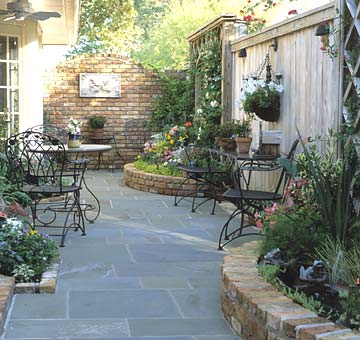 Planters or planting pockets
built into the structure of a
patio allow you to introduce
trees and shrubs that can
soften the hard surfaces and
edges of the structure.
Planters or planting pockets
built into the structure of a
patio allow you to introduce
trees and shrubs that can
soften the hard surfaces and
edges of the structure.
Plantings. Just because a patio is paved doesn't mean it has to go without plants. There are several ways to add plants to a patio setting. The easiest and most versatile way is to use containers. Evergreen shrubs in containers can define areas of a patio, provide privacy and shade, or serve as a windbreak. Smaller pots of perennials, annuals, or bulbs can introduce seasonal color to a patio.
One advantage to using containers is that they are portable, which means you can move the plants around to suit your mood and their needs.
Be sure that the containers match the style of the patio. For example, a whiskey barrel planter may look out of place on a formal brick patio where classic terra-cotta or dressy, painted wood planters such as Versailles tubs provide a more appropriate look.
Another alternative is to have built-in planting areas on the patio. This is best done when you design and build the patio; leave open spaces to act as in-ground containers that you can plant directly into. This method creates more protection from freezing temperatures and plants need less irrigation than if they are grown in containers. It also allows you to grow low ground covers that help soften large expanses of paving.
If you include a built-in in-ground planter, it is vital that the planting hole drain adequately and the soil does not become too alkaline as a result of adjoining mortar. Here's how to get the best results: Once the patio is built, including the planting holes, excavate a hole at least 3 feet deep and fill the hole with water at least 12 inches deep. If the water does not drain within 4 hours, you'll need to improve drainage or plan on using containers or raised beds. If the hole passes the drainage test, line it with heavy plastic, make several large slits in the bottom of the plastic so water can drain, then fill the hole with good soil.
Planning a Container Garden
Covering. A canopy over the patio provides shade and visually contains the area. Options include extending a lath or other open structure from the house (if the patio is attached to the house), building a freestanding structure, such as a pergola, or relying on the limbs of an existing shade tree. It is not necessary to provide a rainproof covering. It is more important to filter the sun and create the illusion of a roof. You might choose to have a canopy over part of the patio with the rest left open. This gives you another good option, because there are times when you want all the sun you can get on the patio.
Drainage. Proper drainage is essential to a successful patio. This is especially true of a sunken patio, which can quickly turn into a pond if it doesn't drain properly. A patio flush with or above ground can be drained by building it with a slight pitch that drains water off the patio and away from the house. It is important to plan the drainage before you build the patio.
A Patio-Shading Pergola
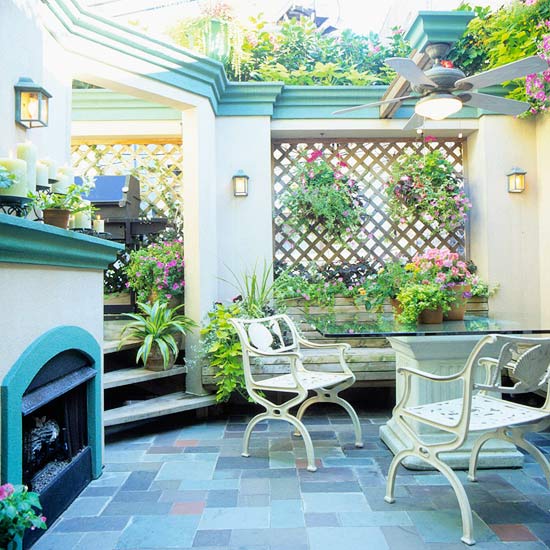 Permanent light fixtures add many
hours of enjoyment to a patio or
deck.
Permanent light fixtures add many
hours of enjoyment to a patio or
deck.
Lighting. Add lighting to make the patio useful even after the sun goes down. If the patio is attached to the house, you can mount floodlights on the eaves for full illumination. Consider putting the lights on a rheostat so you can control the brightness. If the patio is not adjacent to the house, consider mounting lights on tree limbs, an arbor, wood posts, or decorative lampposts.
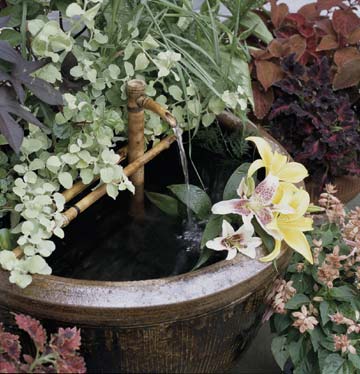 The soothing sound of water can
mask unwanted noise, making even an
urban patio a restful retreat.
The soothing sound of water can
mask unwanted noise, making even an
urban patio a restful retreat.
Water features. Whether elaborate and built-in or simple and freestanding, water features are desirable amenities for a patio. Even a small pond can host a number of plants and or fish. Or install a fountain to provide a bubbling soundtrack to your outdoor experiences.
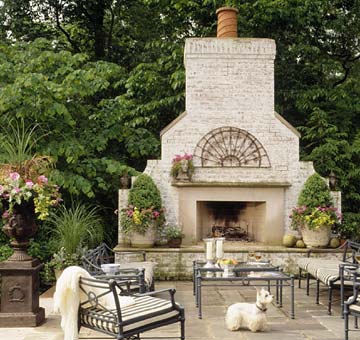 A focal point can be as dramatic
as this fireplace or as simple
as a trellis covered in
climbing roses.
A focal point can be as dramatic
as this fireplace or as simple
as a trellis covered in
climbing roses.
Focal points. In the same way you would decorate a room inside the house, use yard art to accent and otherwise decorate your patio. If the patio can be seen readily from inside the house, the use of ornaments such as wire spheres, metal obelisks, or topiary frames with or without plants can help link the indoors with the outdoors.
A focal point that also has a practical function serves double duty. A simple fire pit or an elaborate patio hearth can warm the body as well as please the eye.
Soothing sound. With weatherproof outdoor speaker systems, you can bring your music outside. For a natural look, consider speaker systems built into realistic models of rocks.
Copyright © www.100flowers.win Botanic Garden All Rights Reserved